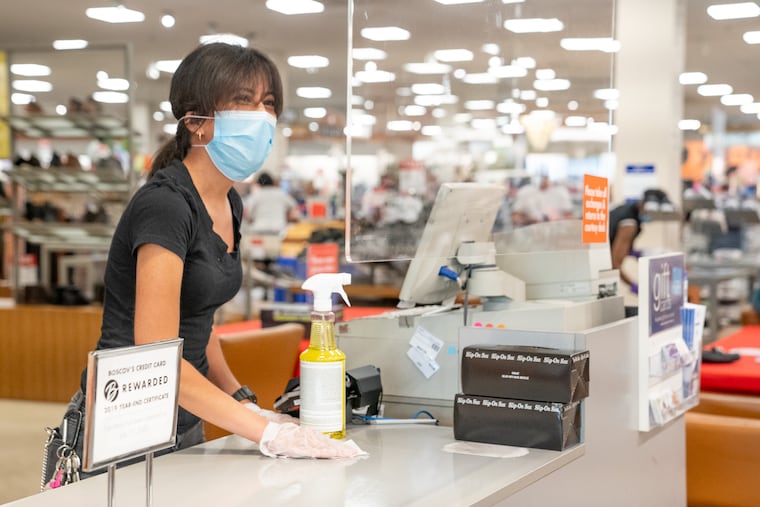How to shop safely now that stores are open
Just because stores are open, does that mean they are safe? Here is what you need to know about the rules and safety.

As Philadelphia continues to reopen, another part of our once-normal life is creeping back: shopping in person at retail stores.
Philly, which went into the yellow phase earlier this month, has been allowed to reopen for business, so long as businesses follow guidelines to help prevent the spread of coronavirus. On Friday, Philly’s suburbs move to green while Philly moves into a green-ish phase. So, even more businesses can open — we can finally get our hair cut — with a slight delay in Philly for riskier businesses, such as indoor shopping malls, which will open July 3.
But just because stores are open, are they safe? Here is what you need to know about the rules and how to shop safely:
What do stores have to do?
Everyone has to wear a mask. That means that shops have to make sure both employees and customers wear them, and enforce social distancing between people while they are in the store, according to state guidelines. The guidelines also recommend using barriers in checkout areas or other measures to separate customers and employees, and the store can only have half its usual occupancy in the yellow phase, and it goes up to 75% in green. Online ordering, delivery, and curbside pickup should be used as much as possible.
They have to clean. A lot. Under the rules, open businesses have to clean frequently and disinfect high-touch areas, provide soap and water for employees to wash their hands, and schedule hourly handwashing breaks. If a shop has multiple checkout lanes, only every other register should be open, and the store should switch between open and closed registers every hour so other lanes can be cleaned.
In Philly, the “Safe Mode” guidelines for retail stores mean additional measures. Stores have to keep returned products out of circulation for 24 hours, remove self-serve displays for things like jewelry and sunglasses or put barriers in front of them, and limit capacity to five customers for every 1,000 square feet of public space. Temperature checks are not required for staff or customers.
» READ MORE: How to summer in Philly: Our 2020 summer guide
What should I look for before I shop?
Before you go into a store, there are some things you should check for, says Dr. Seth Welles, professor of epidemiology and biostatistics at Drexel’s Dornsife School of Public Health. First and foremost, you should check that the store is following masking and social distancing guidelines.
“It’s all about people wearing masks, enforcing that customers wear masks, and the ability to physically distance,” he says. “If they don’t have somebody monitoring that, people should just sort of scan the store quickly and get an idea so they can separate themselves.”
A store with routed, one-way aisles may also be better than one without them, because it helps with physical distancing, he adds. Plastic barriers at the register, wipes, or hand sanitizer for customer use, and extra ventilation — such as leaving windows or doors open — are plusses.
“That’s an important step because ultimately, whether or not there is a successful infection has to do with the density of virus particles,” Welles says. “Ventilation is important to reduce the concentration of virus particles if they’re there.”
» SEARCH OUR FAQ: Your coronavirus questions, answered
How crowded is too crowded?
If a store is so crowded you can’t stay six feet away from others — which shouldn’t happen, given current guidelines — then reconsider going in, Welles says, and try again at a slower time.
Shopping during the week early in the day or after dinner, he says, are less likely to be prime time for shoppers. A Friday afternoon or weekend day, on the other hand, may be too busy for comfort.
How can I lower my risk?
Besides wearing your mask and practicing physical distancing, there’s more you can do to mitigate your risk.
Try having a “designated shopper” in your household — a position in which Welles has found himself throughout the pandemic.
» READ MORE: How to get your haircut safely
“Don’t have everybody running to stores. Try to limit people’s contacts,” he says. “It’s all about reducing the chances that you encounter COVID-19,″ either getting it from others, or unknowingly spreading it yourself.
Limit the number of packages you touch in a store, and disinfect packages or clothing you purchase once you get it home, Welles says. Those steps, he says, are an “ extra step” to take: Remember, infected surfaces are “not thought to be the main way the virus spreads,” according to the U.S. Centers for Disease Control and Prevention.
Avoid cash. Many stores now prefer electronic payments instead of cash, but Welles suggests carrying sanitizing wipes with you to clean your hands and credit card after using a machine “just to be sure.” You could also use gloves, he says, but the point: Keep your hands clean, and regularly wash and sanitize your hands when you’ve been out in the world.
“If you follow a few guidelines, it becomes habit, and it won’t seem like such a hassle when you go in,” he says.